FMF 2024 31 MEU Test Prep
1/412
There's no tags or description
Looks like no tags are added yet.
Name | Mastery | Learn | Test | Matching | Spaced |
|---|
No study sessions yet.
413 Terms
Explain the purpose of Marine Corps Aviation. (primary mission)
Participate as the air component of the MAGTF in the seizure and defense of advance naval bases and to support the conduct of such land operations as may be essential for the prosecution of a naval campaign.
Collateral mission is to participate as an integral component of naval aviation in the execution of such other Navy functions as the fleet commanders so direct.
Explain the six functions and sub-functions of Marine Corps Aviation.
Offensive air support anti air warfare assault support air reconnaisance electronic warfare control of aircraft and missiles
Types of offensive air support
close air support, deep air support
Types of anti-air warfare
Ø Offensive anti-air warfare Ø Air defense Ø Active Air defense Ø Passive Air defense
Types of assault support
Ø Combat assault transport Ø Aerial delivery operations Ø Aerial refueling Ø Air evacuation Ø TRAP Ø Air logistical support Ø Battle space illumination
Types of air reconnaissance
Ø Visual Reconnaissance Ø Multisensory Imagery Reconnaissance Ø Electronic Reconnaissance
Types of electronic warfare
Ø Electronic attack (EA) Ø Electronic protection Ø EW Support
Types of control of aircraft and missiles
Ø Air Direction Ø Air Control
Offensive air support defitinion
air operations conducted against enemy installations, facilities, and personnel to directly assist the attainment of MAGTF objectives by the destruction of enemy resources or the isolation of his military force.
Close air support (CAS)
air action by fixed- and rotary-wing aircraft against hostile targets which are in close proximity to friendly forces and which require detailed integration of each air mission with the fire and movement of those forces.
Deep air support (DAS)
air action against enemy targets at such a distance from friendly forces that detailed integration of each mission with fire and movement of friendly forces is not required.
Deep air support missions are flown on either side of the fire support coordination line; the lack of a requirement for close coordination with the fire and movement of friendly forces is the qualifying factor.
DAS missions include strike coordination, air interdiction, and armed reconnaissance.
Anti-air warfare
that action required to destroy or to reduce to an acceptable level the enemy air and missile threat. It includes such measures as the use of interceptors, bombers, anti-aircraft guns, surface-to-air and air-to-air missiles, electronic attack, and destruction of the air or missile threat both before and after it is launched.
The primary purpose of AAW is to gain and maintain some degree of air superiority.
Offensive AAW
operations conducted against the enemy air or air defense system before it can be launched or assume an attacking role.
Offensive AAW operations in or near the objective area consist mainly of air attacks to destroy or neutralize hostile aircraft, airfields, radars, air defense systems, and supporting areas.
Offensive AAW includes theater missile defense (TMD) attack operations and suppression of enemy air defense operations.
Air Defense
All defensive measures designed to destroy attacking enemy aircraft or missiles in the earth's atmosphere or to nullify or reduce the effectiveness of such attack. Active and Passive Air defense.
Active air defense
Direct defensive action taken to destroy attacking enemy aircraft or missiles or to nullify or reduce the effectiveness of such an attack.
Active air defense includes the use of aircraft, air defense weapons, supporting weapons (weapons not typically used in an air defense role), and EW.
Passive air defense
All measures, other than active defense, taken to minimize the effects of hostile air action. These include the use of cover, concealment, camouflage, deception, dispersion, electronic protection, and protective construction.
Passive air defense is a command responsibility of every unit commander.
Assault support
The use of aircraft to provide tactical mobility and logistic support for the MAGTF, the movement of high priority cargo and personnel within the immediate area of operations, in-flight refueling, and the evacuation of personnel and cargo.
Purpose of Combat Assault Battalion
Combat Assault provides mobility and logistic support to the MAGTF. It can be used to rapidly deploy forces, bypass obstacles, or redeploy forces to meet the enemy threat, thus allowing for a rapid buildup of combat power at a specific time and location.
Aerial Delivery Operations
· Aerial deliver operations transport equipment and supplies to FOBs or remote areas either by landing at the desired location or through air drop.
Aerial refueling
· Aerial Refueling allows MAGTF aircraft to conduct flight-ferrying operations, extend time on station, and extend mission range. In addition, aerial refueling aids in the recovery of damaged or low-fuel aircraft by extending their time in the air, when required.
Air evacuation
· Air evacuation provides transportation of personnel and equipment from FOBs or remote areas by using transport helicopters and fixed-wing aircraft.
Tactical Recovery of Air Craft and Personnel (TRAP)
· TRAP facilitates the recovery of personnel and equipment while preventing additional loss. (implied task associated with all MAGTF operations).
Requires Specially briefed aircrews Conducted when the tactical situation prevents the use of traditional search and reserve techniques.
Normally conducted only when survivors and their locations are confirmed.
Air Logistical Support
Using fixed-wing aircraft to provide assault support of MAGTF forces on the ground in much the same manner as helicopters.
Air logistical support delivers troops, equipment, and supplies to areas beyond helicopter range and lift capability or when surface transportation is slow or unavailable.
Battlespace illumination
Can be provided by both fixed-and rotary-wing aircraft and is used to provide light in the battle space area.
Air reconnaisance
The acquisition of intelligence information by employing visual observation and/or sensors in air vehicles.
Visual reconnaissance
Any airborne platform may conduct visual aerial reconnaissance operations. An observer or pilot can visually search a route, point, or area.
Visual aerial reconnaissance is frequently related to offensive action such as artillery, naval surface fires (NSF), or air support.
Multisensor Imagery Reconnaissance
Includes photographic, side-looking airborne radar, and infrared reconnaissance techniques. When the imagery is processed, it provides intelligence information to all interested commands.
Electronic Reconnaissance
EW-configured aircraft provide the means to detect, identify, evaluate, and locate foreign electromagnetic radiation that is emanating from other-than nuclear detonations or radioactive sources
provides up-to-date electronic order of battle and technical intelligence.
Electronic Warfare (EW)
any military action involving the use of electromagnetic and directed energy to control the electromagnetic spectrum or to attack the enemy
Electronic Attack (EA)
EA is that division of EW involving the use of EM energy, directed energy, or antiradiation weapons. The purpose of these uses is to attack personnel, facilities, or equipment with the intent of degrading, neutralizing, or destroying enemy combat capability.
Electronic Protection
· actions taken to protect personnel, facilities, and equipment from any effects of friendly or enemy employment of electronic warfare that degrade, neutralize, or destroy friendly combat capability.
Electronic warfare support
actions tasked by, or under direct control of, an operational commander to search for, intercept, identify, and locate sources of intentional and unintentional radiated electromagnetic energy for the purpose of immediate threat recognition.
Control of Aircraft and Missiles
Coordinated employment of facilities, equipment, communications, procedures, and personnel that allows the ACE commander to plan, direct, and control the efforts of the ACE to support accomplishment of the MAGTF's mission.
Air detection
The purpose of air direction is to achieve a balance between the MAGTF's finite aviation resources and the accomplishment of the ACE's mission.
Authority to regulate the employment of air resources (including both aircraft and surface-to-air weapons) to maintain a balance between their availability and the priorities assigned for their use.
Air control
· Air control is the authority to direct the physical maneuver of aircraft in flight or to direct an aircraft or surface-to-air weapons unit to engage a specific target.
Air control includes airspace management and airspace control.
How many MAWs are there? How are they organized?
· Marine aviation is divided into three active duty MAWs and one Reserve MAW. · Each MAW has a unique organizational structure. · The MAW provides the personnel and equipment for the MAGTF ACE.
What is the MAW operational mission?
ACE task organizes with various resources from the MAW
ACE supports a MEF with one or more MAWs. Support to the MEF may include assets from more than one MAW that are task organized to form a MAW (reinforced).
MAWs include Marine aircraft, air control, and wing support groups. Each group includes the squadrons and/or battalions that are necessary to complete the groups' roles in Marine aviation.
MAWs and groups are not organized according to tables of organization (T/Os), but rather are task organized to accomplish the missions assigned.
Each of the four wings may have a different organization; however, each wing is capable of performing all six functions of Marine aviation.
What is the function, mission and composition of a Marine Aircraft Group (MAG)?
Smallest aviation unit that is designed to conduct operations with no outside assistance except access to a source of supply.
The primary mission of a MAG VF/VA is to conduct anti-air warfare and offensive air support operations from advance bases, FOBs, and aircraft carriers.
Can also be task-organized into an ACE for a particular mission in order to provide one or more aviation functions to a MAGTF.
Marine Aviation Logistics Squadron (MALS)
Provides aviation-logistic support, guidance, and direction to MAG squadrons on behalf of the commanding officer
Logistic support for Navy funded equipment in the supporting Marine Wing Support Squadron (MWSS), Marine Air Control Squadron (MACS), and Marine wing mobile calibration complex
Intermediate level maintenance, class V ammo logistic support, training, inspection.
Marine Aerial Refueler Transport Squadron (VMGR)
Provides aerial refueling service in support of Fleet Marine Force (FMF) air operations and provides assault air transport of personnel, equipment, and supplies
Provides refueling, air transport evacuation
Marine Tactical Electronic Warfare Squadron (VMR)
Conducts airborne Electronic warfare in support of FMF operations
Marine Unmanned Aerial Vehicle Squadron (VMU)
Operates and maintains a UAV system to provide unmanned aerial reconnaissance support to the MAGTF
Marine Fighter/Attack Squadron (VMFA)
Intercepts and destroys enemy aircraft under all weather conditions and attacks and destroys surface targets
Maintain ability to attack/destroy surface targets, day/night CAS, SEAD.
Marine All Weather Fighter/Attack Squadron (VMFA/AW)
Intercepts and destroys enemy aircraft and surface targets, day or night, under adverse weather conditions
Marine Attack Squadron (VMA)
Attacks and destroys surface targets under day and night visual meteorological conditions and provides helicopter escort.
CAS, recon, defense
Marine Medium Tilt-Rotor Squadron (VMM)
Assault transport of combat troops in the initial assault waves and follow-on stages of amphibious operations and subsequent operations ashore.
Marine Heavy Helicopter Squadron (HMH)
Provides assault helicopter transport of heavy weapons, equipment, and supplies during amphibious operations and subsequent operations ashore.
Marine Medium Helicopter Squadron (HMM)
Provides assault transport of combat troops in the initial and follow-on stages of amphibious operations
Replaced with V22
Marine Light Attack Helicopter Squadron (HMLA)
Provides combat utility helicopter support, attack helicopter fire support, and fire support coordination during amphibious operations and subsequent operations ashore
Utility Helicopter Tasks
Airborne command and control platform for CEs. Armed escort for assault support operations. Combat assault transport of troops, supplies, and equipment. Airborne control for assault support operations.
Attack Helicopter Tasks
Fire support and security Point target/anti-armor operations. Anti-helicopter operations. Armed and visual reconnaissance.
· Explain the Marine Air Command and Control System (MACCS).
Plan and direct ACE operations and employs aviation assets in a responsive, timely, and effective manner. Control aircraft and missiles as well as to establish links with joint, multinational, other Services, and civil air command and control systems.
Allows the ACE commander to conduct centralized planning and optimize the use of limited resources.
It exercises air direction and decentralized execution of the airspace control plan through its subordinate agencies.
What is the function, mission and composition of a Marine Air Control Group (MACG):
Coordinates all aspects of air command and control and air defense within the MAW. Provides the command and staff functions for the MACG commander when deployed as part of the MAGTF ACE.
Plan and coordinate the operations, maintenance, and supply of the Marine Air Command and Control System · Plan and coordinate the air defense operations Coordinate joint and combined air operations and planning
Marine Tactical Air Command Squadron (MTACS)
Provides equipment, maintenance, and operations for the TACC of the ACE
· Provides the operational command post (CP) for the ACE · Assist in coordinating air operations · Assist in planning air operations
Marine Wing Headquarters Squadron (MWHS).
Command, administrative, and supply support for a MAW headquarters and certain elements of the MACG.
· Provide camp facilities and services, including food service, for elements of the Marine wing headquarters and attached squadrons. · Provide for internal security of the MAW headquarters
Marine Air Control Squadron (MACS)
Air surveillance and control of aircraft and surface-to-air weapons for AAW; continuous all-weather radar and non-radar air traffic control services and airspace management in support of a MAGTF.
· Provide deployable detachments that are capable of air surveillance, airspace management, and control of aircraft and SAMs for AAW in support of the MAGTF. · Provide deployable detachments that are capable of providing ATC services at existing or expeditionary airfields and remote area landing sites.
Marine Wing communications Squadron (MWCS)
· The MWCS provides expeditionary communications for the ACE of a MEF
· Provide for the effective command of subordinate detachments. · Assist in the systems planning and engineering of ACE communications.
Install, operate, and maintain expeditionary communications for command and control of the MEF ACE.
Marine Air Support Squadron (MASS)
provides Direct air support center capabilities for control and coordination of fixed- and rotary-wing aircraft operating in direct support of MAGTF forces.
· Receive, coordinate, and process immediate requests for direct air support. · Provide equipment, facilities, and personnel for the operation of air support elements. · Conduct air support control as required to meet MAGTF operational requirements.
Low Altitude Air Defense (LAAD) Battalion
· Close-in, low-altitude, surface-to-air weapons fires in defense of MAGTF assets defending forward combat areas, maneuver forces, vital areas, installations, and/or units engaged in special/independent operations.
· Maintain a primary capability as a highly mobile, vehicle-mounted, and man-portable surface-to-air weapons component of the MAGTF with the ability to rapidly deploy in the assault echelon of an expeditionary operation.
What is the Aviation Combat Element (ACE) of a Marine Expeditionary Force (MEF) and how does it relate to the support/supporting concept of operations?
· Typically, the ACE supports a MEF with one or more MAWs. · Support to the MEF may include assets from more than one MAW that are task organized to form a MAW (reinforced).
What is the ACE of a Marine Expeditionary Brigade (MEB)?
· The ACE of a MEB is a composite Marine Air Group (MAG)
What is the ACE of a Marine Expeditionary Unit (MEU)?
The MEU ACE generally consists of a medium lift helicopter squadron reinforced with several heavy-lift helicopters and fixed wing attack aircraft.
Discuss the three levels of aviation maintenance.
organizational, intermediate, depot
Organizational maintenance
Maintenance which is the responsibility of, and performed by, a using organization on its assigned equipment.
Its phases normally consist of inspecting, servicing, lubricating, adjusting, and replacing parts, minor assemblies, and subassemblies.
DEPOT -LEVEL MAINTENANCE
· Maintenance requiring major rework or a complete rebuild, including manufacture, modification, testing, and reclamation of parts as required.
D-level maintenance serves to support lower levels of maintenance by providing technical assistance and performing maintenance beyond the responsibility of O-level and I-level maintenance.
Intermediate level maintenance
· Maintenance which is the responsibility of, and performed by, designated maintenance activities for direct support of using organizations.
Its phases normally consist of calibration, repair or replacement of damaged or unserviceable parts, the emergency manufacture of nonavailable parts; and the provision of technical assistance to using organizations.
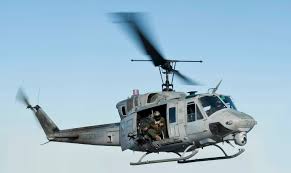
What is this helicopter?
UH-1N (Huey)
twin-engine, two-seat, single-piloted, single-rotor, utility helicopter.
Used in HML/A
Provide utility support for the MAGTF. 13 passengers or provide airborne command and control search and rescue Provide aero medical evacuation of casualties.
two 7.62mm GAU-17 minigun or M-60 machine guns and
defensive armament system (2.75- inch rockets, crew-served .50 caliber machine guns, and fixed forward and crew-served 7.62mm machine guns.
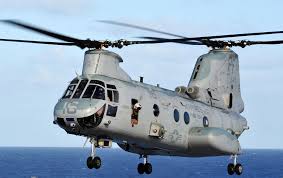
What is this helicopter?
No longer in active inventory. ·
CH-46E "Sea Knight helicopter"
dual-piloted, twin-engine, tandom rotor assault support helicopter. Marine medium helicopter squadrons (HMMs)
Provide assault transport of troops. provisions for 25 personnel. Normal configuration is for 15 combat-loaded troops.
Medical evacuation for 15 litter patients.
The CH-46 can mount two 7.62 M-60 machine guns or two .50 caliber XM-218 machine guns for self-protection.
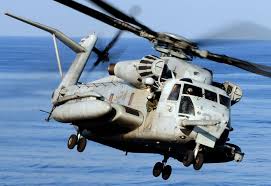
What is this helicopter?
CH-53 / CH53D (Sea Stallion)
Dual piloted, twin-engine, single-rotor assault support helicopter.
Marine heavy helicopter squadron (HMHs) uses the CH-53.
Provide helicopter transport of supplies and equipment.
Transport up to 55 personnel. Normal configuration is 30 combat-loaded troops. 24 litters during medical evacuation operations.
two 7.62 M-60 machine guns or two .50 XM- 218 machine guns for self-protection.
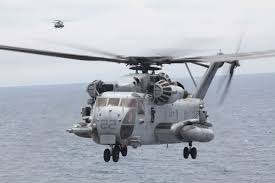
What is this helicopter?
CH-53E
· Is a growth variant of the CH-53D. · It is a dual-piloted, single-rotor helicopter with three engines. Free world's largest helicopter and can transport up to 16 tons over a mission radius of 50 nautical miles.
Doubling the lift of the CH-53D, the CH-53E requires only 10 percent more deck space than a CH-53D with tip tanks.
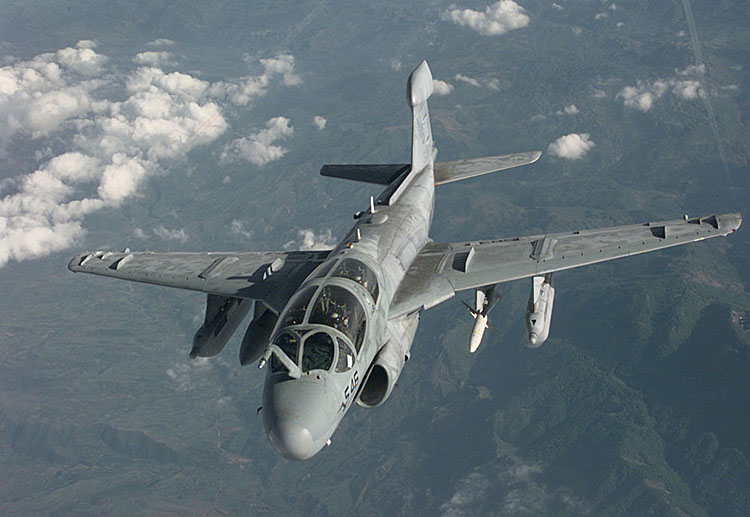
What is this plane?
EA-6B (Prowler) four-place (one pilot and three electronic countermeasures officers), twin-engine, subsonic electronic warfare aircraft. Marine Tactical Electronic Warfare squadrons (VMAQ) use the EA-6B.
suppressing enemy electronic activity and by gaining tactical electronic intelligence.
The aircraft can carry up to five integrally powered pods for jamming early warning, acquisition, and fire control radars.
The aircraft detects, analyzes, and records signals for post mission evaluation.
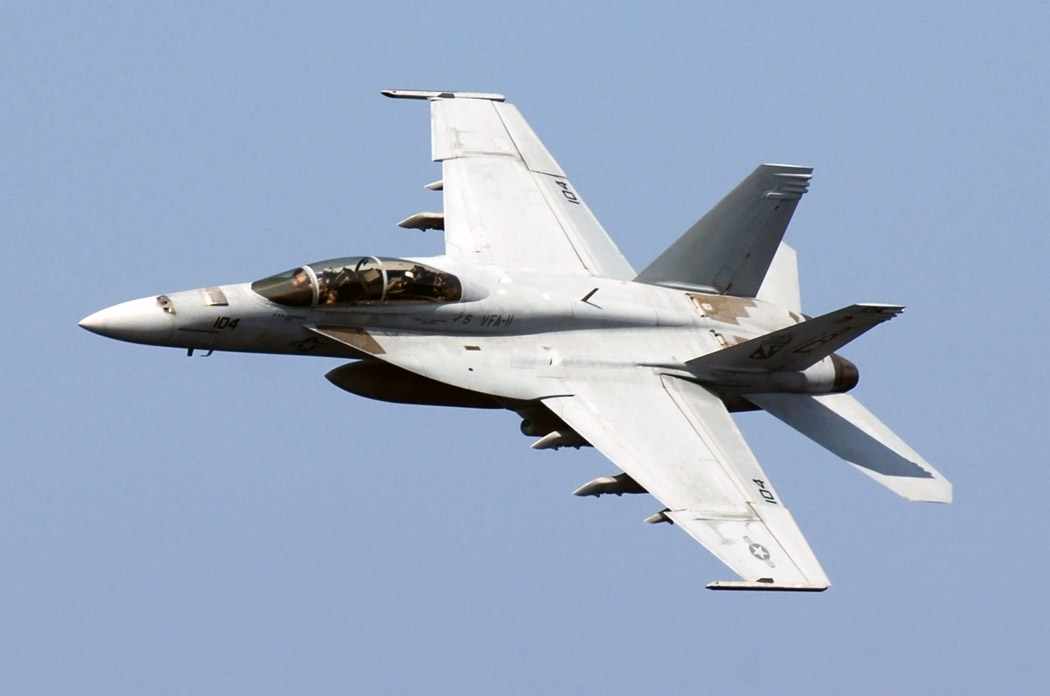
What is this plane?
· The F/A-18 Hornet is a single-place, twin-engine, strike fighter.
Intercept enemy aircraft and perform ground attack. It has an internal 20mm M-61 gun and can carry over 17,000 pounds of ordnance.
· The F/A-18D is the two-seat variant of the F/A-18. VMFA (AW) uses the F/A-18D. A FLIR system (thermal imaging), NVG compatible cockpit lighting, and digital moving map display enable the F/A-18D aircraft to perform ground attacks at night under the weather.
Some F/A-18D aircraft carry the advanced tactical airborne reconnaissance system (ATARS).
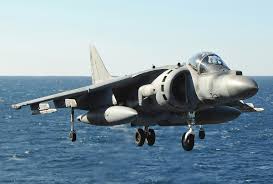
What is this plane?
AV-8 "Harrier" - replaced by F35.
Single-seat, transonic, vectored-thrust, light attack aircraft. · Marine attack squadron (VMAs) use the AV-8B.
GAU-12 25mm gun system and can carry up to 9,200 pounds of external ordnance.
· Its V/STOL capability provides increased responsiveness to MAGTF commander's offensive air support requirements through basing flexibility and high sortie rates.
The angle rates bombing system (ARBS) allows accurate first pass attacks and high kill probability using laser spot or TV tracking.
The aircraft has an inertial navigation system.
Its forward looking infrared (FLIR) system, night vision goggle NVG compatible cockpit t lighting, and moving map display allow ground attacks at night under the weather.

What is this plane?
MV-22 "Osprey"
Multi-engine, dual-piloted, self-deployable, medium lift; vertical takeoff and landing (VTOL) tilt rotor aircraft designed for combat, combat support, combat service support, and Special Operations missions worldwide.
It will replace the Corps' aged fleet of CH-46E and CH-53D medium lift helicopters.
Primary function: Amphibious assault transport of troops, equipment and supplies from assault ships and land bases.

What is this plane?
· The KC-130 is a four-engine, turboprop, aerial refueler and assault transport aircraft. Marine aerial refueler transport squadrons (VMGRs) use the KC-130.
The KC-130 can aerial refuel aircraft equipped with refueling probes, and they can ground refuel helicopters and AV-8s (Harrier) at austere landing sites.
· Additional tasks include aerial delivery of troops and cargo, and operation of airborne direct air support center.
· As a tactical transport, the KC- 130 can carry 92 troops, 64 paratroops, 74 litters, or 35,000 pounds of cargo.
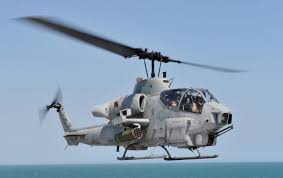
What is this helicopter?
AH-1 Super Cobra
two-place, tandem-seat, twin-engine helicopter capable of land- or sea-based operations . · The AH-1W provides fire support and fire support coordination to the landing force during amphibious assaults and subsequent operations ashore.
· The AH-1W can fire TOW, Hellfire, and Sidewinder missiles and can be outfitted with Zuni rocket launchers.
The AH-1W is currently being outfitted with a Night Targeting System/Forward Looking Infrared Radar that provides laser range finding/designating and camera capabilities.
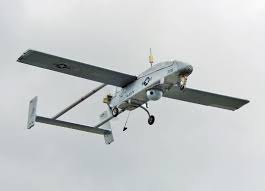
What is this UAV?
Pioneer
1 of 2 USMC UAVs. · Started 1985
Flown nearly 14,000 flight hours and supported every major U.S. contingency operation to date.
Flew 300+ combat reconnaissance missions during Persian Gulf operations in 1990-91.
Flown in contingency operations over Bosnia, Haiti and Somalia;
most recently it flew in Task Force Eagle and IFOR (implementation force) operations again over Bosnia.
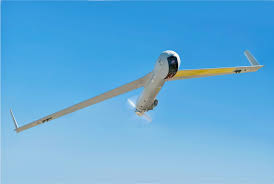
What is this UAV?
Scan Eagle
2/2 USMC UAVs. ·
Small, autonomous remote-control airplane with a stabilized camera.
It generally flies itself, but we have operators to tell it where to go.
Long-endurance capabilities and small size make it the ideal plane for aerial surveillance.
One of the smallest UAVs to have a stabilized video camera in it.
Orbit a certain point for up to 15 plus hours.
Launched by Superwedge pneumatic wedge catapult system. 50 foot high pole skyhook retrieves it.
Explain the purpose and employment of a Marine Division (MARDIV).
The mission of the Marine division is to execute amphibious assault operations, maintain ground amphibious forcible-entry capability and perform subsequent land operations in any operational environment using combined arms tactics.
Name the types of regiments and battalions in a Marine division.
3 (THREE) Infantry Regiments Artillery Regiment Assault Amphibian Battalion Combat Engineer Battalion Headquarters Battalion Light Armored Reconnaissance Battalion
Tank Battalion (defunct)
What is the Ground Combat Element (GCE) of: Marine Expeditionary Unit (MEU)?
Infantry Battalion (rein)
Three infantry companies reinforced by Weapons company Artillery battery combat engineer platoon LAR platoon assault amphibious platoon scout sniper platoon
reconnaissance platoon Tank platoon (when required) SFCP (shore fire control party) TOW section
What is the Ground Combat Element (GCE) of: Marine Expeditionary Brigade (MEB)?
· 1 infantry regiment (reinforced with:) · Tank Battalion (-) · Light Armored Reconnaissance Company · Assault Amphibian Company · 3 Artillery Battery's · 1 EFSS Battery Expeditionary Fire Support · 1 HMMARS Battery · 2 Combat Engineer Platoon
GCE of a MEF is
A MARDIV
What is the Mission/Function of Infantry regiment
The primary mission of the infantry regiment is to locate, close with, and destroy the enemy by fire and maneuver or to repel his assault by fire and close combat.
What is the Mission/function of an artillery regiment
The mission of artillery in the Marine division is to furnish close and continuous fire support by neutralizing, destroying, or suppressing targets that threaten the success of the supported unit.
What is the Mission/function tank battalion (defunct)
The mission of the tank battalion is to close with and destroy the enemy by using armor protected firepower, shock effect, and maneuver
and to provide anti-mechanized fire in support of the Marine division.
What is the Mission/function of HQ Battalion
The primary mission of the headquarters battalion is to exercise command, control, and administration of the Marine division.
What is the Mission/Purpose of an Assault Amphibian Battalion
The mission of the assault amphibian battalion is to land the surface assault elements of the landing force and their equipment in a single lift from assault shipping during amphibious operations to inland objectives
and to conduct mechanized operations and related combat support in subsequent operations ashore.
What is the Mission/function Light armored reconnaisance battalion
The mission of the LAR battalion is to conduct reconnaissance, security, and economy -of-force operations and, within capabilities, conduct limited offensive or delaying operations that exploit the unit's mobility and firepower.
Speed and firepower, combined with maneuver, are used to exploit the offense in all types of combat operations.
What is the Mission/function of a Combat Engineer Battalion
The mission of the combat engineer battalion is to enhance the mobility, counter mobility, and survivability of the Marine division through close combat engineer support and to provide the limited general engineering support that is required for the functioning of the Marine division.
What is the Mission/function of reconnaissance battalion
The mission of the Reconnaissance battalion is to conduct amphibious reconnaissance, ground reconnaissance, surveillance, Battle space shaping and limited scale raid in support of the Marine Division and its subordinate elements
Purpose/Employment of AAV
The amphibious assault vehicle (AAV) is employed to conduct mechanized (mech) operations and related combat support in subsequent operations ashore.
Light armored vehicle (LAV) characteristics
LAV-25 (Scout) lightly armored eight-wheeled amphibious vehicle.
Stabilized 25mm cannon a pintle-mounted 7.62mm machine gun coaxially mounted 7.62mm machine gun capable of engaging mechanized targets and personnel.
Manned and operated by a driver, a gunner, and a vehicle commander is capable of carrying four infantry scouts in the rear
Can be deployed be airlift or sealift.
M1A1 Tank (defunct)
The M1A1 combat (main battle tank uses high speed, maneuverability, and a variety of weapons to attack and destroy enemy tanks, equipment, and forces.
· The tank is equipped with: Laser rangefinder Thermal Imaging System (TIS) Main gun, M256 120mm Coaxial machinegun, M240 7.62mm Commander's Machinegun, M2 .50 cal Grenade Launcher M250 Engine: Turbine engine
What is Fire Support and fire support Coordination
· Fire support is fires that directly support land, maritime, amphibious, and special operations forces to engage enemy forces, combat formations, and facilities in pursuit of tactical and operational objectives
· Fire support coordination is the planning and executing of fires so that targets are adequately covered by a suitable weapon or group of weapons
Discuss the role of the Fire Direction Center (FDC)
The FDC serves as the "brain" of the system. It receives the call for fire from the observer, determines firing data, and converts them to fire commands (technical fire direction). The FDC transmits the fire commands to the sections designated to fire the mission.
Explain the mission of the Marine Logistics Group (MLG).
The MLG provides general and direct support and sustained combat logistics above the organic capabilities of supported elements.
How is MLG employed?
Supply Maintenance Transportation General engineering Health service Other services (postal, exchange, legal, graves registration)
What are Battalions/Subunits of 3rd MLG
Headquarters and Service Battalion
3rd Maintenance Battalion, 3rd Supply battalion
Combat Logistics Regiment (3, 37). Transportation support battalion, landing support battalion, motor transportation battalion.
9th Engineering Support Battalion 3d Medical Battalion 3d Dental Battalion
Responsibility of Maintenance Battalion
The maintenance battalion provides general support and intermediate (3d and 4th echelon) maintenance support for Marine Corps-furnished tactical ordnance, engineering, motor transport, communications electronics, and general support equipment of the MEF.